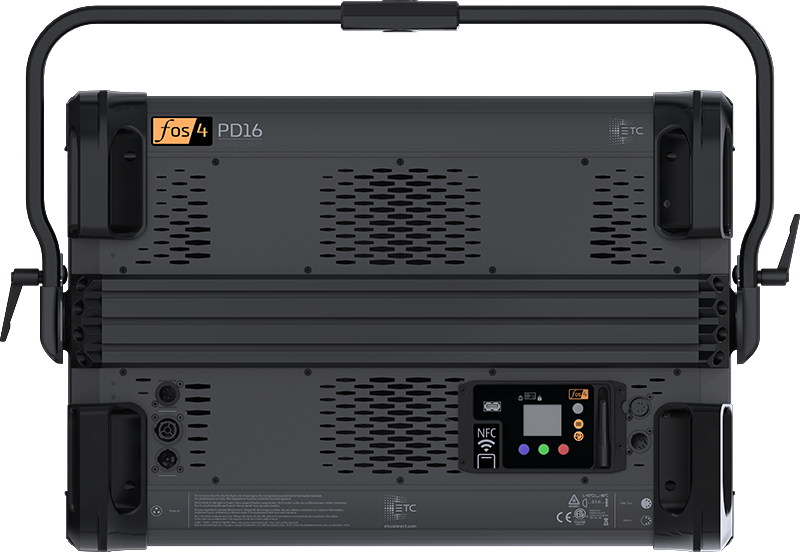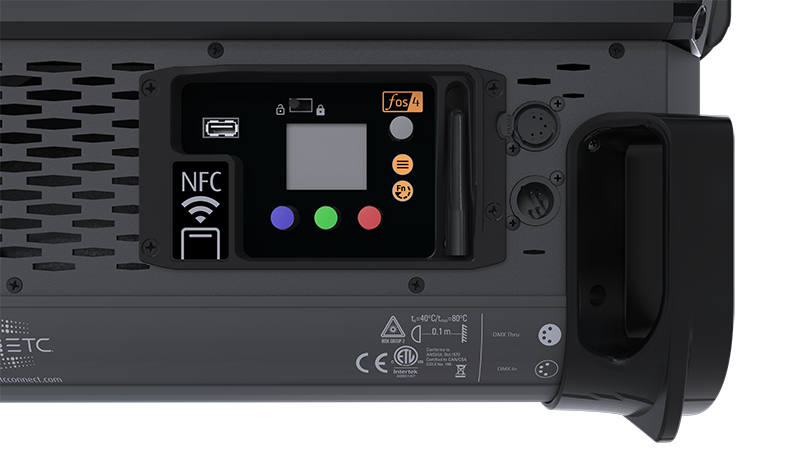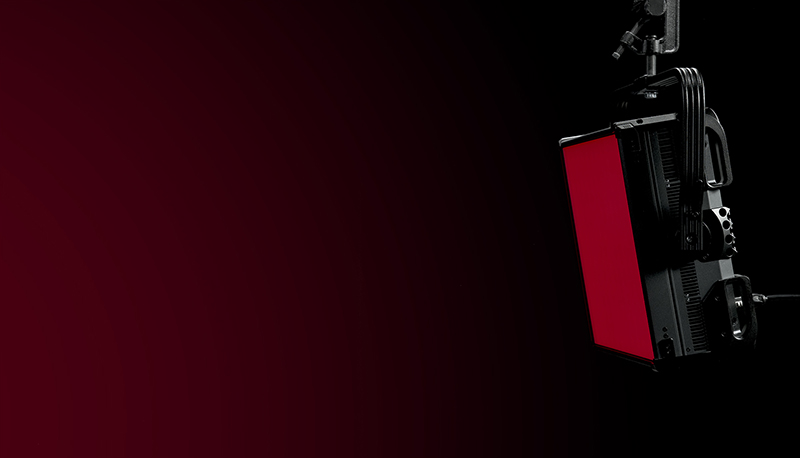
ETC fixtures, like the Source Four ellipsoidal and PAR, were purposely built for theatrical use. Because of their practicality, the television and studio world adopted them quickly and are still using them in studios around the world today. As ETC develops new LED fixtures, such as Source Four LED and Desire series, they, too are found in studios and theaters alike.
If ETC can make great theatrical fixtures that are used regularly in studios, why not create a purpose-built studio light? Well, that is exactly what they did. ETC started by looking at size, form factor, functionality, operation and, most importantly, color quality and control of light, all of which are extremely important in studio use. Let us check out the fos/4 Panel line of studio fixtures.

Hang
I received the fos/4 Panel Lustr 8 (fos/4 PL8), the smallest version they offer, but when I picked up the box, I was surprised by how heavy it was. The yoke was thick, extruded aluminum, with no bend or flex whatsoever. The body of the luminaire is a mixture of cast and aluminum. There are adjustable tilt locks on both sides of the yoke. There are two dedicated safety cable attachment points in addition to the handles and heavy-duty yoke — all of which are designed for safety cables.
There is a structural rail system on the rear of all fixtures in this line, called the Griprail. It is a utility mount for all kinds of things like battery mounts, tablets, additional handles, clamps and couplers, safety cables, and allows for third party accessories. It accepts standard M6 T-nuts, so you can mount whatever you like to it or use it to mount the fixture, great for low trim applications.

Connections
I was excited to see the first fixture from ETC with Neutrik’s powerCON TRUE1 power connectors. Because the large unit can utilize up to 1,475 watts, it only has an input connector, but the medium and small panels have pass-throughs. There are 5-pin DMX in/thru for hard-wired DMX, and City Theatrical’s Multiverse for wireless control. Speaking of wireless, the fixture uses Near-Field Communication (NFC) along with ETC’s Set Light app, which enables the addressing and configuration of fixtures wirelessly from one’s phone. Simply hold your phone near the fixture to obtain the current configuration, or to upload the new one. The NFC pushes and pulls information even when the fixture is off.

On-Board Controls
The user interface on the rear is a full color display and extremely intuitive. The bottom three knobs are for quick user-recordable push selection of presets. The defaults are 3200K, 4500K and 5600K, and the fourth top right knob adjusts intensity. The knobs have color changing LEDs inside (go figure!) which provide additional feedback and guidance. Standalone operation is useful in the studio world, and ETC made this simple.
There is a menu button for adjusting Multiverse settings, local settings and diagnostics. Below that is a function button that gives access to presets, effects and DMX operating mode. In DMX operation, there are five modes to choose from, ranging from 1-channel to 12-channels each with various levels of control. While in DMX control, the bottom of the screen scrolls to show the channel assignments. To set the starting address, use the left knob and scroll to the desired address. There is a physical UI lock to prevent accidental (unintentional) change.
Lights On
The fixture booted up in five seconds and began to nicely fade up. After the sixth second, it was at full output and was surprisingly bright! Specifications state 20,569, 41,058 and 61,587 lumens for each panel size respectively. ETC offers a few options relating output to quality. You can select the brightest output, best spectral color, or hybrid — a mixture of the two. With the standard opaque diffusion lens, the output is a smooth and soft beam angle of 108°.

Color
The PL8 I evaluated was the Lustr X8 flavored array in the small 8-by-24-inch. The Lustr X8 is their full color version consisting of eight colors: deep red, red, amber, lime, green, cyan, blue and indigo — all of which are Lumileds’ LUXEON C emitters. The other available array is Daylight HDR (tunable white) consisting of six colors: deep red, red, mint, cyan, blue and indigo.
Both fixtures utilize the new-to-market deep red emitter. Standard red is about 635nm and deep red is even higher, at about 660nm. It extends the top end of the color spectrum, reaching for a deeper red that allows cameras to capture a better picture, particularly with skin tones.
The efficacy, or lumens per watt, is 52, and the arrays have a L70 of 54,000 hours minimum. Both dimming and strobe are electronic and performed fantastically. The strobe flashes at a maximum 20Hz (times per second) or can pulse or be set to a random flash pattern. The dimming curve was flawless and faded all the way out to 0%.
Cooling
Thermal management is key on LED fixtures and is a balancing act between convection cooling (using heat sinks) and forced cooling with fans. When noise is important, fans are not desirable. ETC put a large heat sink inside the fixture body perfectly centered on the yoke and a small fan to assist, when needed, the convection cooling system.
I must say that I did not realize the fixture even had a fan, because I never heard it. When I looked through the vents at the rear of the fixture, I could see the fan spinning, but could not hear it. And my ear was only inches away (and last time I checked, I had excellent hearing!).
On Air
The IP20-rated fos/4 panel is a versatile luminaire that can be used as a front key or fill light, side, back, set, or backdrop wash, including chroma key screens. Available accessories include Chimera egg crates in various degrees, light banks, barn doors and diffusion lenses. The panel fixtures are purpose-built camera-ready studio luminaires with the highest in color quality and control available.
At a Glance
Bright, Versatile and Quiet
ETC’s fos/4 is a new powerfully bright luminaire dedicated for studio applications. They are available in small, medium, or large sizes and your choice of one of two color arrays (Lustr X8 or Daylight HDR). Both flavors have a vast color gamut and excellent color reproduction. Supporting the fixture’s versatility, ETC has a complete line of optional accessories.
PROS:
- LED source
- Lustr X8, Daylight HDR
- Color Temperature Range: 1900 — 10450 K
- Warranty: 5 years (fixture), 10 years (LED array)
- Numerous control options
CONS: None
FEATURES
- Three size options (S, M, L)
- Two color array options (Lustr X8/Daylight HDR)
- On-board controls
- Wireless or wired DMX
- Near-Field Communication
- Up to 62,000-lumen output
- Griprail accessory mounting system
- Numerous available accessories
SPECS
- Sizes: 8” (D); 24” (W); 8,” 16” or 24” (H)
- Weight: 32, 56 or 79 lbs.
- Wattage: 475W, 955W or 1,475W
- Voltage: 100-240, 50/60Hz (auto-ranging)
- MSRP: $4,700, $6,850 or $9,800
Manufacturer: ETC
More Info: http://studio.etcconnect.com


